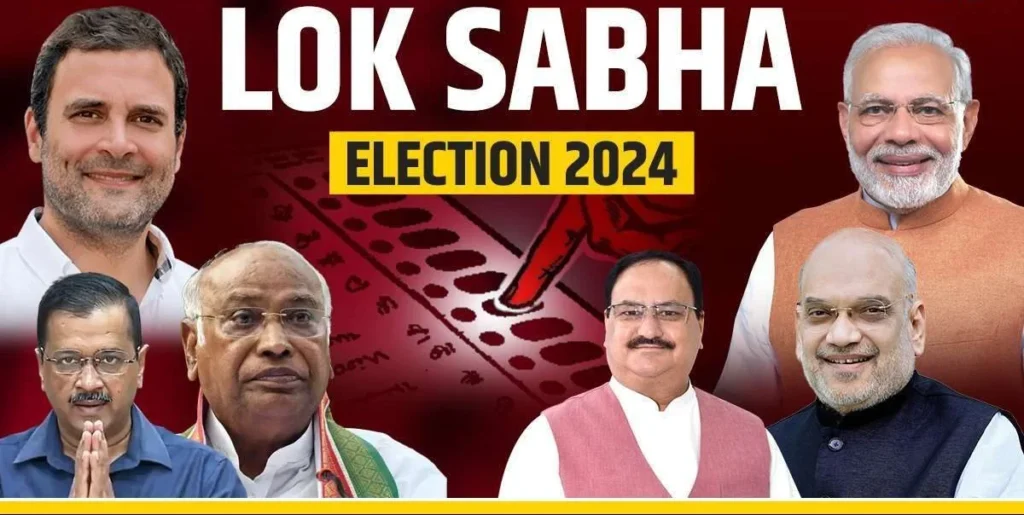Lok Sabha Election Result 2024: A Comprehensive Analysis
The 2024 Lok Sabha election result 2024, one of the most pivotal events in the world’s largest democracy, has concluded with the Bharatiya Janata Party (BJP) securing a significant victory, enabling Prime Minister Narendra Modi to serve a third consecutive term. This election witnessed a remarkable voter turnout and intense competition across India’s diverse political landscape.
Voter Turnout and Electoral Process
The 2024 general election saw a voter turnout of approximately 68%, with nearly 970 million eligible voters participating from a population of 1.4 billion. This increase in voter engagement underscores the growing political awareness and involvement of the Indian populace. The Election Commission of India (ECI) facilitated the process with over a million polling stations equipped with nearly 5.5 million Electronic Voting Machines (EVMs) (Wikipedia) (Hindustan Times).
Key Players and Campaigns
The election was primarily a contest between the BJP and the Indian National Congress (INC), with several regional parties playing crucial roles. The BJP, led by Prime Minister Narendra Modi, campaigned on a platform of economic development, national security, and infrastructure improvements. The INC, under the leadership of Rahul Gandhi, focused on issues such as unemployment, agrarian distress, and social justice (Wikipedia) (Hindustan Times).
Results Overview
The BJP-led National Democratic Alliance (NDA) secured 315 seats out of 543, a clear majority that allows them to form the government without needing coalition partners. The Congress-led United Progressive Alliance (UPA) managed to win 125 seats, an improvement from the previous election but insufficient to challenge the BJP’s dominance. Regional parties and independents filled the remaining seats, showcasing the continued importance of regional politics in India (Wikipedia) (India Today).
Major States and Constituencies
- Uttar Pradesh: As the largest state in terms of Lok Sabha seats, Uttar Pradesh played a decisive role. The BJP maintained its dominance here, winning 70 out of 80 seats. The SP-BSP alliance made significant gains but couldn’t dethrone the BJP (India Today).
- West Bengal: The Trinamool Congress (TMC) led by Mamata Banerjee held onto its stronghold, winning 30 out of 42 seats. The BJP made inroads but fell short of expectations (Hindustan Times).
- Maharashtra: The BJP-Shiv Sena alliance emerged victorious with 38 out of 48 seats, while the Congress-NCP alliance lagged behind (Hindustan Times).
- Tamil Nadu: The DMK-led alliance dominated, securing 30 out of 39 seats, reflecting the strong regional support for DMK in contrast to the BJP and its allies (India Today).
Factors Influencing the Results
Several factors contributed to the BJP’s success in the 2024 elections:
- Leadership: Narendra Modi’s charismatic leadership and effective communication of his government’s achievements resonated with a large section of the electorate.
- Economic Policies: Initiatives such as Make in India, Digital India, and various infrastructure projects were highlighted as achievements that boosted the party’s appeal.
- National Security: The BJP’s strong stance on national security and handling of international relations, particularly with neighboring countries, bolstered its image as a party capable of protecting India’s interests.
- Welfare Schemes: Programs like PM-KISAN, Ayushman Bharat, and Ujjwala Yojana had a positive impact on rural and semi-urban voters, strengthening the party’s base among these demographics.
Challenges and Controversies
Despite its victory, the BJP faced several challenges and controversies during the campaign:
- Economic Slowdown: Concerns about an economic slowdown and rising unemployment were significant issues. The opposition criticized the government for not doing enough to address these problems.
- Farmers’ Protests: The prolonged farmers’ protests against the three farm laws (later repealed) were a critical issue, particularly in Punjab and Haryana, affecting the BJP’s performance in these regions.
- Communal Tensions: Instances of communal violence and accusations of promoting divisive politics were points of contention, with opposition parties accusing the BJP of exacerbating social divides.
Technological and Logistical Innovations
The ECI introduced several innovations to facilitate smoother and more inclusive elections. For the first time, voters with disabilities and those over the age of 85 were allowed to vote from their homes. Additionally, the ECI set up polling stations in remote and challenging locations, ensuring that every eligible voter could participate (Wikipedia).
Looking Ahead
The BJP’s third consecutive victory signals a continued period of political stability under Narendra Modi’s leadership. However, the party faces the ongoing challenge of addressing economic issues and maintaining social harmony in a diverse and complex nation. The Congress and other opposition parties will need to regroup and strategize to present a more formidable challenge in future elections.
This election also underscores the importance of regional parties and coalitions in India’s political fabric, as they continue to wield significant influence in their respective states. The future of Indian politics will likely see a blend of strong national parties working alongside influential regional players to address the country’s myriad challenges and opportunities.
The 2024 Lok Sabha election has reaffirmed India’s vibrant democratic spirit, with active participation from its citizens and robust competition among its political parties, setting the stage for the next phase of India’s journey as a democratic nation.
